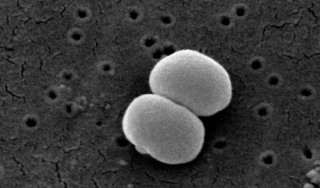| Oil acne | |
|---|---|
| Specialty | Dermatology |
Oil acne is an occupational skin condition caused by exposure to oils used in industry. [1]
| Oil acne | |
|---|---|
| Specialty | Dermatology |
Oil acne is an occupational skin condition caused by exposure to oils used in industry. [1]

Acne also known as acne vulgaris, is a long-term skin condition that occurs when dead skin cells and oil from the skin clog hair follicles. Typical features of the condition include blackheads or whiteheads, pimples, oily skin, and possible scarring. It primarily affects skin with a relatively high number of oil glands, including the face, upper part of the chest, and back. The resulting appearance can lead to lack of confidence, anxiety, reduced self-esteem, and, in extreme cases, depression or thoughts of suicide.

Isotretinoin, also known as 13-cis-retinoic acid and sold under the brand name Accutane among others, is a medication used to treat skin diseases like harlequin-type ichthyosis, and lamellar ichthyosis, and severe cystic acne or moderate acne that is unresponsive to antibiotics. Isotretinoin is used off-label to treat basal cell carcinoma and squamous cell carcinoma, although clinical evidence suggests it is not effective in this setting. It is a retinoid, meaning it is related to vitamin A, and is found in small quantities naturally in the body. Its isomer, tretinoin, is also an acne drug.

Minocycline, sold under the brand name Minocin among others, is a tetracycline antibiotic medication used to treat a number of bacterial infections such as some occurring in certain forms of pneumonia. It is generally less preferred than the tetracycline doxycycline. Minocycline is also used for the treatment of acne and rheumatoid arthritis. It is taken by mouth or applied to the skin.

Hidradenitis suppurativa (HS), sometimes known as acne inversa or Verneuil's disease, is a long-term dermatological condition characterized by the occurrence of inflamed and swollen lumps. These are typically painful and break open, releasing fluid or pus. The areas most commonly affected are the underarms, under the breasts, perineum, buttocks, and the groin. Scar tissue remains after healing. HS may significantly limit many everyday activities, for instance, walking, hugging, moving, and sitting down. Sitting disability may occur in patients with lesions in sacral, gluteal, perineal, femoral, groin or genital regions; and prolonged periods of sitting down can also worsen the condition of the skin of these patients.

Cutibacterium acnes is the relatively slow-growing, typically aerotolerant anaerobic, gram-positive bacterium (rod) linked to the skin condition of acne; it can also cause chronic blepharitis and endophthalmitis, the latter particularly following intraocular surgery. Its genome has been sequenced and a study has shown several genes can generate enzymes for degrading skin and proteins that may be immunogenic.

Tretinoin, also known as all-trans retinoic acid (ATRA), is a medication used for the treatment of acne and acute promyelocytic leukemia. For acne, it is applied to the skin as a cream, gel or ointment. For acute promyelocytic leukemia, it is effective only when the RARA-PML fusion mutation is present and is taken by mouth for up to three months. Topical tretinoin is also the most extensively investigated retinoid therapy for photoaging.

Adapalene is a third-generation topical retinoid primarily used in the treatment of mild-moderate acne, and is also used off-label to treat keratosis pilaris as well as other skin conditions. Studies have found adapalene is as effective as other retinoids, while causing less irritation. It also has several advantages over other retinoids. The adapalene molecule is more stable compared to tretinoin and tazarotene, which leads to less concern for photodegradation. It is also chemically more stable compared to the other two retinoids, allowing it to be used in combination with benzoyl peroxide. Due to its effects on keratinocyte proliferation and differentiation, adapalene is superior to tretinoin for the treatment of comedonal acne and is often used as a first-line agent. The Swiss company Galderma sells adapalene under the brand name Differin.

Hyperpigmentation is the darkening of an area of skin or nails caused by increased melanin.

Acne keloidalis nuchae (AKN), also known as "acne keloidalis", "dermatitis papillaris capillitii", "folliculitis keloidalis", "folliculitis keloidis nuchae", and "nuchal keloid acne", is a destructive scarring folliculitis that occurs almost exclusively on the occipital scalp of people of African descent, primarily men.

A comedo is a clogged hair follicle (pore) in the skin. Keratin combines with oil to block the follicle. A comedo can be open (blackhead) or closed by skin (whitehead) and occur with or without acne. The word "comedo" comes from the Latin comedere, meaning "to eat up", and was historically used to describe parasitic worms; in modern medical terminology, it is used to suggest the worm-like appearance of the expressed material.

Staphylococcus epidermidis is a Gram-positive bacterium, and one of over 40 species belonging to the genus Staphylococcus. It is part of the normal human microbiota, typically the skin microbiota, and less commonly the mucosal microbiota and also found in marine sponges. It is a facultative anaerobic bacteria. Although S. epidermidis is not usually pathogenic, patients with compromised immune systems are at risk of developing infection. These infections are generally hospital-acquired. S. epidermidis is a particular concern for people with catheters or other surgical implants because it is known to form biofilms that grow on these devices. Being part of the normal skin microbiota, S. epidermidis is a frequent contaminant of specimens sent to the diagnostic laboratory.
Acne fulminans is a severe form of the skin disease, acne, which can occur after unsuccessful treatment for another form of acne, acne conglobata. The condition is thought to be an immunologically induced disease in which elevated level of testosterone causes a rise in sebum and population of Cutibacterium acnes bacteria. The increase in the amount of C acnes or related antigens may trigger the immunologic reaction in some individuals and lead to an occurrence of acne fulminans. In addition to testosterone, isotretinoin may also precipitate acne fulminans, possibly related to highly increased levels of C acnes antigens in the patient's immune system. Acne fulminans is a rare disease. Over the past several years, fewer cases of this disease have occurred, possibly because of earlier and better treatment of acne. Approximately 100 patients with acne fulminans have been described.
Tropical acne is unusually severe acne occurring in the tropics during seasons when the weather is hot and humid.
Acne conglobata is a highly inflammatory disease presenting with comedones, nodules, abscesses, and draining sinus tracts.
Excoriated acne is a mild acne accompanied by extensive excoriations caused by the person picking at the pimples.

Neonatal acne, also known as acne neonatorum, is a type of acne that develops in newborns, typically before 6 weeks of life. It presents with open and closed comedones on the cheeks, chin and forehead.
Acne mechanica is an acneiform eruption that has been observed after repetitive physical trauma to the skin such as rubbing, occurring from clothing or sports equipment. In addition to those mechanisms, the skin not getting enough exposure to air also contributes to the formation of acne mechanica. It is often mistaken as a rash that forms on sweaty skin that is constantly being rubbed, but in reality, it is a breakout of acne mechanica. The term "acne" itself describes the occurrence in which hair follicles in the skin get clogged by oil, dead skin cells, dirt and bacteria, or cosmetic products and create a pimple. Pimples can vary in type, size, and shape, but the sole basis of them occurring is the same - the oil gland in the pore becomes clogged and sometimes infected, which creates pus in order to fight the infection and subsequently causes the development of swollen, red lesions on the skin.
Acne with facial edema occurs uncommonly, and is associated with a peculiar inflammatory edema of the mid-third of the face. The exact cause of edema in relation to acne is unknown. Treatment includes facial stockings as well as a combination of prednisone and isotretinoin.
Infantile acne is a form of acne that begins in very young children. Typical symptoms include inflammatory and noninflammatory lesions, papules and pustules most commonly present on the face. No cause of infantile acne has been established but it may be caused by increased sebaceous gland secretions due to elevated androgens, genetics and the fetal adrenal gland causing increased sebum production. Infantile acne can resolve by itself by age 1 or 2. However, treatment options include topical benzyl peroxide, topical retinoids and topical antibiotics in most cases.

Clascoterone, sold under the brand name Winlevi, is an antiandrogen medication which is used topically in the treatment of acne. It is also under development in a higher concentration for the treatment of androgen-dependent scalp hair loss, under the brand name Breezula. The medication is used as a cream by application to the skin, for instance the face and scalp.